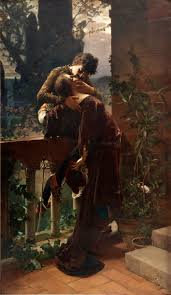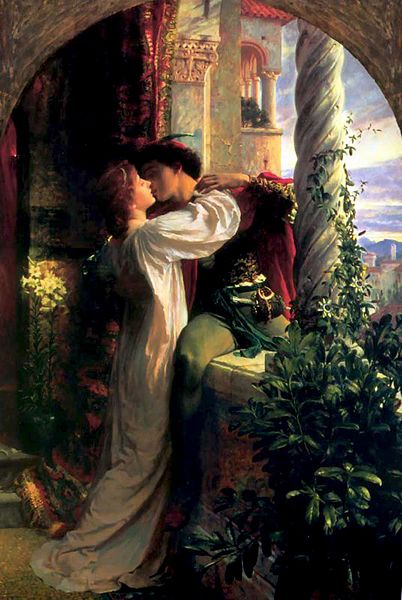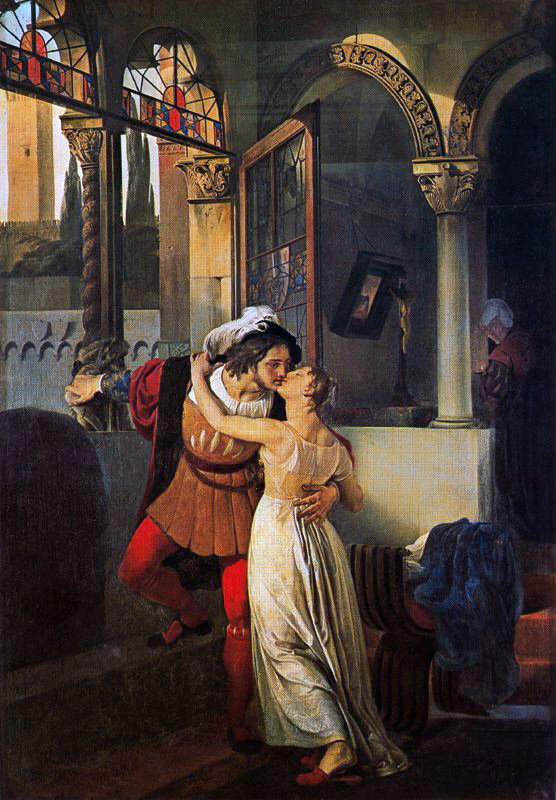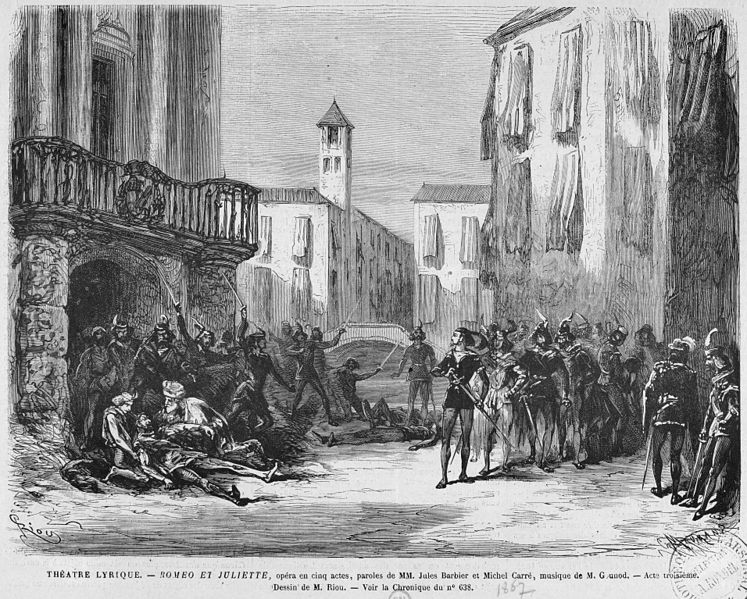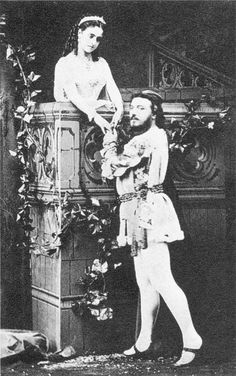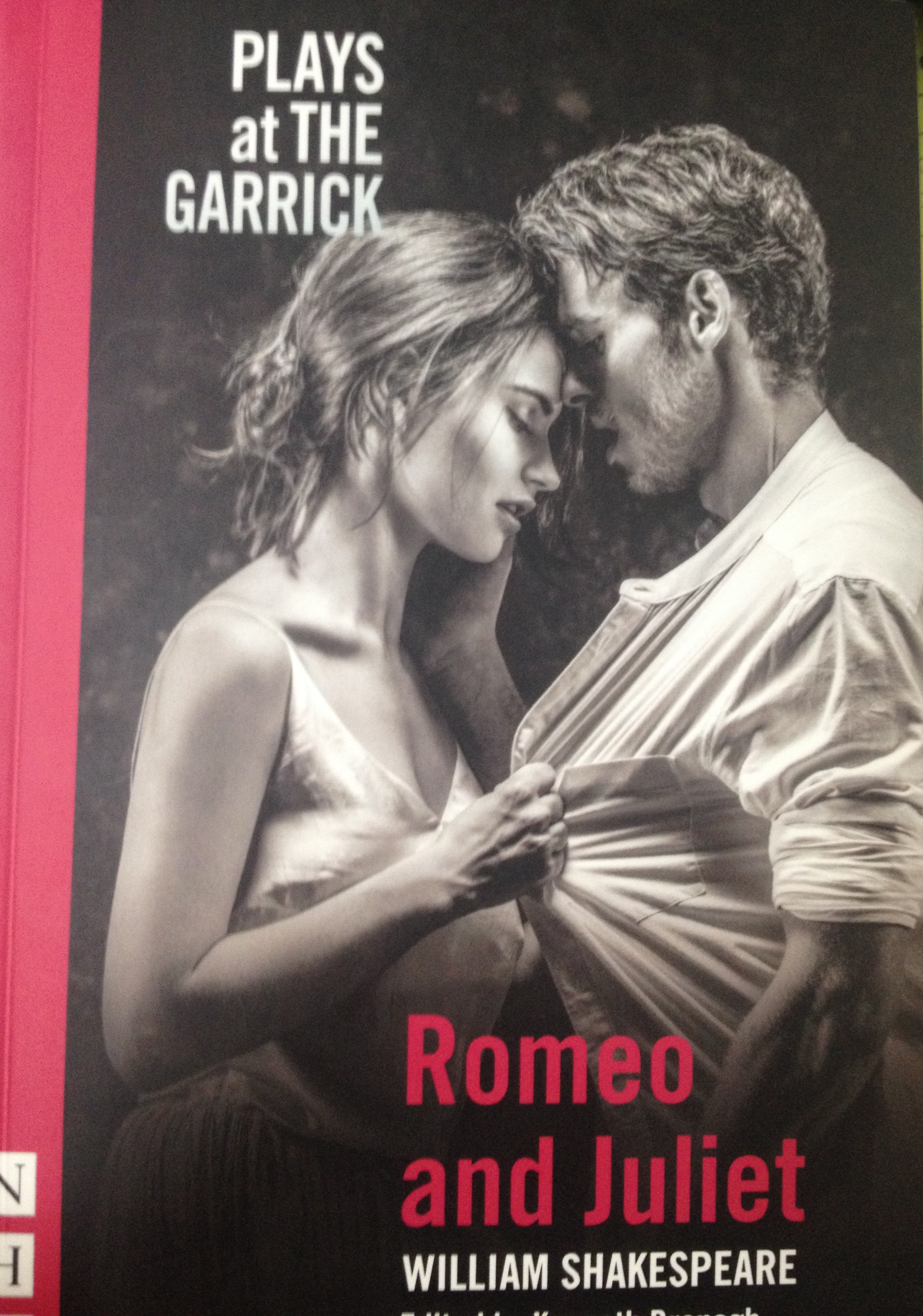Difference between revisions of "How Shakespeare through the Centuries Still Lives On"
From Londonhua WIKI
Mthatfalvi (talk | contribs) |
Mthatfalvi (talk | contribs) |
||
| Line 106: | Line 106: | ||
''Thou'rt no foe, 'tis thy name!''" <ref>Barbier, J., Carré, M., Northcott, R. A., & Shakespeare, W. (1905). Romeo et Juiliette (French-English edition ed.). London: Published by the executors of the late Sir Augustus Harris. 5, Victoriaeet, London, S.W.</ref><br><br> | ''Thou'rt no foe, 'tis thy name!''" <ref>Barbier, J., Carré, M., Northcott, R. A., & Shakespeare, W. (1905). Romeo et Juiliette (French-English edition ed.). London: Published by the executors of the late Sir Augustus Harris. 5, Victoriaeet, London, S.W.</ref><br><br> | ||
In the 2016 adaptation, not much of the script changed from the original Shakespeare version. For example, the same part (Act 2 Scene 2) Juliet speaks saying: | In the 2016 adaptation, not much of the script changed from the original Shakespeare version. For example, the same part (Act 2 Scene 2) Juliet speaks saying: | ||
| − | <br> | + | <br>Ay me!<br><br>O Romeo, Romeo, wherefore art thou Romeo?<br> |
''Deny thy father and refuse thy name.''<br> | ''Deny thy father and refuse thy name.''<br> | ||
''Or, if thou wilt not, be but sworn my love,''<br> | ''Or, if thou wilt not, be but sworn my love,''<br> | ||
Revision as of 19:57, 17 May 2017
How Shakespeare through the Centuries Still Lives On
|
|
Contents
- 1 How Shakespeare through the Centuries Still Lives On
- 2 Abstract
- 3 Introduction
- 4 Section 1: Background
- 5 Section 2: Deliverable
- 6 Conclusion
- 7 External Links
- 8 Image Gallery
- 9 References
Abstract
The paragraph should give a three to five sentence abstract about your entire London HUA experience including 1) a summary of the aims of your project, 2) your prior experience with humanities and arts courses and disciplines, and 3) your major takeaways from the experience. This can and should be very similar to the paragraph you use to summarize this milestone on your Profile Page. It should contain your main Objective, so be sure to clearly state a one-sentence statement that summarizes your main objective for this milestone such as "a comparison of the text of Medieval English choral music to that of the Baroque" or it may be a question such as "to what extent did religion influence Christopher Wren's sense of design?"
Introduction
This project is about the timeless message of Shakespeare's Romeo & Juliet that is still relevant today. The story of Romeo & Juliet has been told around the world for hundreds of years. It is a beautiful story about lovers who are domed to never be together because of human prejudice and spite. Because this play is timeless in its message of love, there have been many different adaptations and storytelling techniques for this play. The question is even with all of these different adaptations, does Shakespeare;s original story and message still live on? One way to answer this question is to dive into the story, its inspiration, and to look at two artistically different interpretations and find the real theme & message that still lives on today.
For this project, research of the story, inspiration and two interpretations of Romeo and Juliet can benefit with finding that Shakespeare theme and message through the ages. This research will look at the performance details, style, costumes, mood, theme and overall message that the writers & directors wanted to send through the story. Two London plays which appear very different in style and technique can be compared for an in depth research into the message of the story of Romeo and Juliet. One interpretation of Romeo and Juliet that will be looked at was performed in 1867 as an opera at the Covent Gardens which is now know as the Royal Opera House. Another interpretation was a 1950's style performance done at the Garrick Theatre in 2016. Despite the drastic difference in interpretation and performance, the original message that Shakespeare want to give through this play still lives on.
Section 1: Background
Shakespeare’s Romeo and Juliet Story & Inspiration
Story
The plot of the play of Romeo and Juliet is about two star crossed lovers who are forbidden to be together by their families quarrel. According to a Shakespeare Resource website, the two families, the Capulets which is Juliet's family and the Montagues which is Romeo's family, have been quarreling for years.[1] They meet at a masquerade ball which is put on by the Capulets and they fall in love at first sight. They eventually decided to secretly marry and plan on running away. Sadly though Romeo ends up killing Tybalt, who is Juliet's cousin, and is sent to exile. Juliet is then forced by her family to marry Paris. She decides to fake her death to escape the arranged marriage and then to run away with Romeo. Unfortunately, Romeo never receives word that Juliet's death is fake. He finds her dead then goes to her side and poisons himself. When Juliet awakes and see's her Romeo dead she then ends her life for real. In the end, both families do reconcile but sadly at the cost of Romeo and Juliet's lives.
Inspiration
William Shakespeare wrote Romeo & Juliet around the 1590's. Researches to this day still cannot exactly pinpoint what inspired the play. While researching Shakespeare's possible inspirations three main researched theories come up. One being the inspiration of the are the time period, another being real people Shakespeare knew, and a poem that Shakespeare could have read.
In Elizabethan time, while England was growing in arts and culture however, according to a Shakespearean study done on the historical context of Romeo & Juliet, it was still suffering from religious persecution towards the Catholics.[2] When Henry VIII became the head of the English church, Catholics were then threatened to either convert to Protestation or die. When Mary I succeed her father after her brother Edward VI, she didn't persecute the Catholics because she was Catholic herself like her mother, but instead persecuted the Protestants. This was why she got her nickname "Bloody Mary". Then when Mary I died, Elizabeth I succeeded her. Elizabeth I brought back the Protestant church but started to executed Catholics again like her father. It is recorded in Shakespeare history that Shakespeare's father was a Catholic. Now no real proof exists for William Shakespeare's religion but it is a thought that he did base Romeo and Juliet on this time period event especially with the fight going on between Catholicism and Protestantism. Think of the names Romeo (Rome, where the Catholic church is based) and Juliet (Anglican English church of England).
Another possible inspiration is a real couple that Shakespeare knew. According to a Shakespeare Solved website that writes articles for the University of Oxford's Bodleian Library & The Royal Shakespeare Company, Henry Wriothesley the 3rd Earl of Southampton was a close friend to Shakespeare and was a courtier to Queen Elizabeth I. [3] His mother was Mary Browne whose father was the 1st Viscount Montagu (does this sound similar to Montagues). Henry fell in love with a woman named Elizabeth Vernon who was one of Queen Elizabeth I's ladies-in-waiting. Ladies-in-waiting were no allowed to marry and an alliance between Henry & Elizabeth was not favored by the queen especially since both family were different in religious views (Henry's family was Catholic and Elizabeth Vernon's family was Protestant) . Henry was the ward of William Cecil and he already arranged a marriage for Henry which Henry refused. When Cecil died in 1598, Henry and Elizabeth then married. This did not make the queen happy and she put them both in jail. They were eventually released and their love story ended happily with a long life and children.
The poem "The Tragical History of Romeus and Juliet" written by Arthur Brooke in 1562 is consider as the most likely inspirational source for the story of Romeo and Juliet. [4] The story plot based in Verone is close to the same as Shakespeare's plot for Romeo & Juliet. Some things are different like for example Juliet is wooed by Romeus two weeks instead of just one night. The words that the characters speak are different in the poem then the play. They do though convey the important theme of timeless romance and tragedy.
Shakespeare’s Romeo and Juliet at the Covent Gardens (1867)
According to the annals of the Covent Gardens Theatre from 1732 to 1897, the opera "Romeo and Juliette" by Charles Gounod was performed at the Covent Garden's on July 11 1867. [5] Adelina Patti played Juliet and Signor Mario played Romeo. The opera was a newly composed by Charles Gounod with words by J.Barbier & M.Carré and received many fantastic reviews at the time. One praising review was published in the Watson's Art Journal in London at the time stating that "It is impossible to speak too highly of the manner at which Roméo e Giulietta is placed upon the stage at Covent Garden Theatre". [6] This opera was a new rendition of Romeo and Juliet at the time in 1867.
Performance Summary
The opera is composed in five acts and performed in french. Before the first act, a chorus sings the prologue. The first act starts at the Capulet's Place at a Masquerade ball. Romeo sneaks into the ball with his friends and meets Juliet and falls for her at first sight. The second act is the balcony scene when Romeo meets Juliet. The Third Act starts in the friar's cell when Romeo and Juliet secretly marry and continues with Romeo's page going to the Capulets house then draws one of their servants to combat. The combat grows by the addition of Romeo, Tybalt and others. Eventually Romeo kills Tybalt. The act ends when Romeo is then banished by the Duke. Act four is in Juliet's bedroom where Romeo visits her for the night then leaves before her father and the friar come to tell her she will marry Paris. The friar, after Juliet's father leaves, gives Juliet a potion to take to fake her death. She then takes the potion. The fifth and final act is in the Capulets tomb where Juliet is buried. Romeo enters and believing Juliet is dead consumes poison. Before the poison kills Romeo, Juliet awakes and finds her Romeo dying from the poison. They speak heartfelt words and while Romeo dies Juliet stabs herself with Romeo's dagger. Ending the opera with them both dead. [7]
Dramatic Elements
The opera opened in the the late 1800's in Paris France. The words are sung in french and the style of the opera & costumes is 18th century french aristocrat. The set looked like late 18th century Verona Italy. Gounod did the same approach with Romeo & Juliet as he did with another one of his famous operas Faust and toned down the supporting characters in the play. The supporting characters are as is said only supporting. Juliet's nurse for example her character is taken down to the point where she is almost non existent. This is Gounod's way of emphasizing the main characters of the opera. Romeo and Juliet are either or both in every scene of the opera with entire scenes to themselves mutable times.
The music sets the theme for the opera in every act. The first act starts in a triumphant Forte with goes then to an Andante with a chorus. This is the ball scene so then the music goes back to a happy upbeat sound. The second act is performed soft and Dolce. Two scenes are in the third act and the first is Dolce music for Romeo and Juliet's music which grows to a triumphant Forte with trumpets ending the scene. The second scene is more tense and speeds up and grows louder with the chorus. This scene is the fighting scene. The forth act has a beautiful parting with Romeo and Juliet together for the first time since their marriage before romeo leaves for banishment. Then the scene goes to Juliet with her father and the Friar where the music becomes the feelings of Juliet with desperation and homelessness. The Friar with a deep bass voice gives hope to Juliet though and the scene ends slow with Juliet taking the poison. The fifth act starts with a sad and slow trumpets when Romeo finds his Juliet "dead". The scene is very dramatic and shows the passion that both Romeo and Juliet have for each other. The opera ends with sad triumphant horns emphasizing the end of timeless classic love story. [8]
Overall Review
An opera is a style of theater performance that makes a story more dramatic and heartfelt. By drawing out all of the words in song, the viewer is more captivated and emotional about the story and characters. Gounod by making Romeo & Juliet an opera created a way of telling the story where the audience could become more emotional to the pain and loss of love. He also showed this theme by ending the scene not when the Montagues and Capulets reunite, but when both Romeo & Juliet die. The message that Gounod wants to send through this opera is that the loss of love is real and painful.
Shakespeare’s Romeo and Juliet at the Garrick Theatre (2016)
For the 2016 year at the Garrick Theatre in London, an interpretation of Romeo and Juliet was performed with directors Kenneth Branagh and Rob Ashford. Rob Ashford was also the choreographer in this production. This interpretation got mixed reviews one from The Guardian newspaper published in London by theatre critic Micheal Billington saying that "The whole thing is done with a speed and vigour that ensures we are never bored;..." [9] . Another review from The Independent newspaper in London by an Arts and Features writer Holly Williams saying that "The pair power through with appropriately teenage high drama, but the show never plumbs the full depths of tragedy." [10] Despite mixed reviews, this interpretation of Romeo and Juliet is unique in its style and theme.
Performance Summary
Richard Madden and Lily James played the star roles. The performance follows the same script of the original Shakespeare's Romeo and Juliet but with some lines cut and some added humor. The play keeps to the same Shakespearean words and sayings. One added part for Juliet is that in Act 1 Scene 5 she is singing a song when Romeo sees her for the first time. The characters are kept the same as in the original play however, Mercutio is not a young man but a sarcastic and nicely dressed older guy. This creates an approach to the story where Mercutio is a loyal older friend, someone who speaks from experience and Romeo looks to him for advice.
Dramatic Elements
The set and period the play is done in is 1950's Italy Verona. The men wear dark suits and the women wear petticoats.The main scenic design looks like a roman building with white marble columns and steps. The whole play keeps this main set and uses props & lighting to change scenes. The background music throughout the play is modern. Different kinds of passion can be shown throughout this interpenetration. The passion of love, war, conflict, fear and pain. There is a theme of darkness and light that is shown through the stage, lighting and characters. Especially in the Romeo & Juliet death scene, the white light showing Juliet's white gown is contrasted with Romeo's dark black suit. The supporting characters are given more notice and development. For example, the Nurse, according to actress Meera Syal in an interview, is portrayed as a comic caricature but is shown to be human and have great feelings towards Juliet who she considers as a daughter. [11] She portrays the Nurse in Garrick Theatre's Romeo & Juliet 2016 performance. The mood throughout the play is serious energetic and passionate.
Overall Review
The message that this performance gives is that the story is timeless. Throughout the set, music, costumes and speech, no single time period can be pinned on this interpretation of Romeo & Juliet. The different passion of love, war, conflict, fear and pain can also be shown in this interpretation. For example, Romeo speaks what he feels passionate love for Rosaline then changes quickly when he sees Juilet and speaks that:
"...Did my heart love till now? Forswear it, sight,
For I ne'er saw true beauty till this night." [12]
This interpretation had a great approach to a old but true theme.
Section 2: Deliverable
Both interpretations are given the same story. However, their interpretation of the story is different. What this project wants to find is the theme and message that both interpretations are trying to give to their audience. To do this lets look in depth at the similarities and differences of the to plays. Lets start with the differences.
In this section, provide your contribution, creative element, assessment, or observation with regard to your background research. This could be a new derivative work based on previous research, or some parallel to other events. In this section, describe the relationship between your background review and your deliverable; make the connection between the two clear.
The Differences
Performance
Both performance executions were very different. That alone could be explained by the fact that they were done in different time periods and at different places. However lets look at both performances. In the 1867 interpretation, the performance is written entirely as an french opera. All of the words are sung and even though most of the original writing is kept, a lot of lines for the script were newly written just for this interpretation. For example, in the original balcony scene from Shakespeare's Romeo & Juliet (Act 2, Scene 2) one of the lines Juliet says to herself is:
"Ah me!
O Romeo, Romeo! wherefore art thou Romeo?
Deny thy father and refuse thy name;
Or, if thou wilt not, be but sworn my love,
And I'll no longer be a Capulet.
'Tis but thy name that is my enemy;
Thou art thyself, though not a Montague.
What's Montague? it is nor hand, nor foot,
Nor arm, nor face, nor any other part
Belonging to a man. O, be some other name!
What's in a name? that which we call a rose
By any other name would smell as sweet;
So Romeo would, were he not Romeo call'd,
Retain that dear perfection which he owes
Without that title. Romeo, doff thy name,
And for that name which is no part of thee
Take all myself."[13].
In the opera (Act 1, Scene 2) Juliet sings in french:
"Ah me!-And still I love him!
Romeo, why art thou Romeo?
Doff then thy name, for't is no part,
My loof thee! What rose we call
By other name would smell as sweetly:
Thou'rt no foe, 'tis thy name!" [14]
In the 2016 adaptation, not much of the script changed from the original Shakespeare version. For example, the same part (Act 2 Scene 2) Juliet speaks saying:
Ay me!
O Romeo, Romeo, wherefore art thou Romeo?
Deny thy father and refuse thy name.
Or, if thou wilt not, be but sworn my love,
And I'll no longer be a Capulet.
'Tis but thy name that is my enemy.
Thou art thyself, though not a Montague.
What's Montague? It is nor hand, nor foot,
Nor arm, nor face, nor any other part
Belonging to a man. O, be some other name!
What's in a name? That which we call a rose
By any other name would smell as sweet;
So Romeo would, were he not Romeo called,
Retain that dear perfection which he owes
Without that title. Romeo, doff thy name,
And for that name, which is no part of thee,
Take all myself."[15].
Another point of difference we can see is that the supporting characters how they are portrayed characters in both versions are also different.
The opera in 1867 has only 10 supporting characters besides Romeo & Juliet. The chorus and background non speaking cast do not count. These characters are also not given great emphasis on their growth in character through the story as we see with the main characters Romeo & Juliet. In the 2016 version, there are 18 supporting characters with speaking roles including the main two characters. These characters are also given the opportunity in the play to have human characteristics and to grow in virtue or in hate depending on the character. More emphasis in supporting characters is given in the 2016 interpretation then the 1867 interpretation.
Dramatic Elements
similarities in style? mood? theme? costumes?
The Similarities
Performance
performance where? did they not have same characters?
Dramatic Elements
differences in style? mood? theme? costumes?
Conclusion
same message in both performances even though they are done differently in different time periods.
In this section, provide a summary or recap of your work, as well as potential areas of further inquiry (for yourself, future students, or other researchers).
External Links
If appropriate, add an external links section
Image Gallery
If appropriate, add an image gallery
References
- ↑ Shakespeare, W. (n.d.). Romeo and Juliet Synopsis. Retrieved May 11, 2017, from https://www.playshakespeare.com/romeo-and-juliet/synopsis
- ↑ Romeo and Juliet Historical Context. (2009, December 05). Retrieved May 12, 2017, from https://shakespearestudy.wordpress.com/plays/romeo-and-juliet-historical-context/
- ↑ Schajer, D. B. (1970, January 01). Shakespeare Solved. Retrieved May 11, 2017, from http://shakespearesolved.blogspot.co.uk/2012/09/the-real-romeo-and-juliet.html
- ↑ Brooke, Arthur. BROOKE'S 'ROMEUS AND JULIET' BEING THE ORIGINAL OF SHAKESPEARE'S 'ROMEO AND JULIET' NEWLY EDITED BY J. J. MUNRO. Ed. J.J. Munro. New York: Duffield and Company; London: Chatto & Windus, 1908.
- ↑ Wyndham, Henry Saxe. (1906). The annals of Covent Garden Theatre from 1732 to 1897. London : Chatto & Windus
- ↑ Gounod's Romeo and Juliet. (1867). Watson's Art Journal, 7(16), 244-246. Retrieved from http://www.jstor.org.ezproxy.wpi.edu/stable/20647340
- ↑ Barbier, J., Carré, M., Gounod, C., Shakespeare, W., Sapio, R., Pollack, O., & Moody-Manners Opera Company. (1912). Romeo & Juliet: Opera in five acts. Hull: White & Farrell.
- ↑ Gounod, C., Barbier, J., Carré, M., Baker, T., Henderson, W. J., & Shakespeare, W. (1925). Romeo and Juliet: Opera in five acts. New York: G. Schirmer.
- ↑ Billington, M. (2016, May 26). Romeo and Juliet review – Branagh gives tragedy a touch of la dolce vita. Retrieved May 12, 2017, from https://www.theguardian.com/stage/2016/may/26/romeo-and-juliet-review-branagh-lily-james-richard-madden-garrick-theatre
- ↑ Williams, H. (2016, May 25). Romeo and Juliet, The Garrick Theatre, London: Teenage high drama, but Kenneth Branagh's show never plumbs the full depths of tragedy. Retrieved May 12, 2017, from http://www.independent.co.uk/arts-entertainment/theatre-dance/reviews/romeo-and-juliet-the-garrick-theatre-london-teenage-high-drama-but-kenneth-branagh-s-show-never-a7049321.html
- ↑ Shakespeare, W., Branagh, K., & Oram, C. (2016). Romeo and Juliet. London: Nick Hern Books.
- ↑ Shakespeare, W., Branagh, K., & Oram, C. (2016). Romeo and Juliet. London: Nick Hern Books.
- ↑ Shakespeare, William. Romeo and Juliet. MIT. Web.rieved May 15, 2017
- ↑ Barbier, J., Carré, M., Northcott, R. A., & Shakespeare, W. (1905). Romeo et Juiliette (French-English edition ed.). London: Published by the executors of the late Sir Augustus Harris. 5, Victoriaeet, London, S.W.
- ↑
